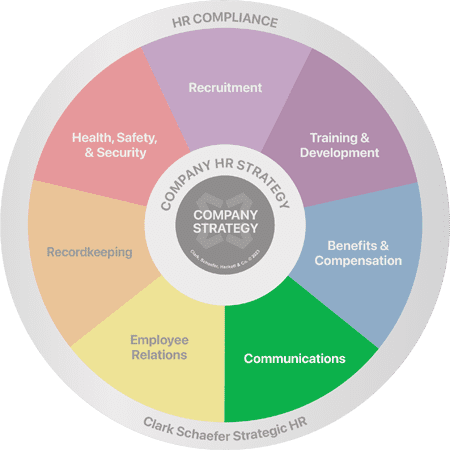Performance Management Plan: The Individual Strategic Plan
Last Updated on January 6, 2022 / HR Strategy

Performance management has become an ever-increasing critical tool to success for businesses. Regardless of what is happening in the economy and other external factors, the success of any organization is always about its people! AND, as humans, we are typically far more productive when we have clear goals, expectations, and feedback.
“Would you tell me please, which way I ought to go from here?”
“That depends a good deal on where you want to get to,” said the Cat.
“I don’t much care where-” said Alice
“Then it doesn’t much matter which way you go,” said the Cat.
– From Alice’s Adventures in Wonderland
If you have had the opportunity to attend one of my strategic planning sessions, you’ve seen me use this quote in reference to developing a company or department’s strategic plan. But, a strategic plan is a waste of time and effort if it does not get communicated and tied to the performance of all employees through Individual Strategic Plans. Whether this is a formal or informal process depends a great deal on your particular organization.
Start with an informal process
If your organization can effectively communicate and link the strategic goals of the organization to each individual’s goals AND regularly provide feedback to an employee, then you may be able to succeed without a formal performance management tool. Even with an informal process, you will need to develop a system with specific checkpoints to be sure the communication is constant and two-way to ensure that the employee is on-track and getting both positive and constructive feedback in a timely manner.
Developing a formal performance management plan
If the world were perfect, I would encourage everyone to use an informal process; however, time seems to get the best of us. Without a formal process, goals are unclear at best, and feedback is rare. To facilitate a process that is successful for both the employee and the organization, a formal performance management system can “work for you.” A well-designed performance management plan should make your job easier; not more cumbersome.
To begin developing a system or any new program or initiative, I like to use Development Dimension International’s (DDI) six Checkpoints for Implementation:
1. OUTCOMES — What results am I looking for?
For your performance management system, you’ll need to think about what you hope to gain from the system. For example, increased productivity, improved retention, increased employee morale, and improved communications.
2. BENEFITS — Why is this important? What’s in it for me?
Both the company and the employee need to know why they are doing this in order to feel ownership for the system. Your organization may see the benefits as some of the outcomes listed above, as well as a method for linking individual performance to the organization’s performance. Individuals may see it as a way to continue to develop and grow with the organization while adding value back to the company. Remember, lack of growth opportunities and meaningful work are two of the top reasons employees leave their jobs.
3. BARRIERS — What might prevent me from being successful?
In order to ensure the success of your system, you need to anticipate any barriers and identify what you will do to prevent or minimize the impact of those barriers. Some examples may be: resistance to change, time constraints, or lack of management support.
4. SUPPORT — What resources are available?
You’ll need to clearly identify what resources or individuals are available to help you develop and implement the system. Once you have identified your resources, you’ll want to include them in the process as much as possible in order to obtain their buy-in and benefit from what they can offer. Some examples of support are: top management, employees, expert consults, other organizations, budget, and customer needs.
5. APPROACH — What steps must I take to achieve my goals?
By identifying the outcomes, benefits, barriers, and supports, you will be better able to begin mapping out the approach for developing and implementing your performance management plan. It will be important to be specific, including the who, when, duration, etc. Some questions you may want to consider include:
What’s needed to facilitate goal setting, feedback, and documentation?
Many times organizations assume performance management is the evaluation at the end of the review period. However, an effective performance management plan begins with the development of a performance plan at the BEGINNING of the evaluation period. This performance plan or individual strategic plan is a living document that may need updating throughout the plan year.
In general, systems should include both competencies and goals. With most of our clients, we develop a group of core competencies or behaviors that mirror the values of the organization. Plus, we develop individualized goals for each employee that are tied to the goals of the business. There are many canned and customizable systems out there that can help you identify what you want to include in your system. To help you generate ideas, you may want to seek samples from other companies or resources such as these performance appraisal templates. Be sure any piece of information you include on the form adds value rather than creates work for others. Plus, be sure the form is a tool not a rule!
How often do you need to formally or informally discuss goals and feedback?
Like your business plan, a performance plan is a living document and the goals and feedback should be ongoing and constant. However, it often takes a formal get-together for this to actually happen. If your organization is not one to proactively meet throughout the plan year, then a formal meeting, even if short, should be arranged at least quarterly to ensure an employee is getting timely feedback and still supporting both their individual and the organization’s strategic plan(s). Plus, if you summarize this quarterly meeting your end of the year review will be a breeze.
Who needs to be trained on performance management and coaching?
We all could benefit from training on performance management and coaching. Even if you are the best manager, a refresher on performance management simply helps you continuously grow as a proactive manager. Formal training can also help ensure all managers are working with the same set of tools, including assistance with the seeming struggle about how to be a manager and a coach at the same time. Learning what has been successful and not successful with others will help everyone in the organization succeed.
What will you do to involve both employees and management in the process?
Employees and supervisors will not take the time for performance planning and reviews if management does not support it. Management has to realize the value added (i.e., increased productivity, improved morale, retention) of performance management and demonstrate their support of the system to all employees. This may require involving a key management player in the development and implementation of the system.
Like management, employees will be more encouraged to take the feedback and direction of performance management seriously if they are involved with the development of the system. To do this, you can either survey employees to identify their needs or include them in a team tasked to evaluate and develop a program. Clear and open communication will be critical to the success of this process.
How will the system be tied to compensation?
Of course, any system is going to be much more open and honest when there is little or no connection to pay. The catch is you need to have some way to measure employee performance, in order to provide performance-based increases. You’ll need to develop a clear philosophy and supporting policy for merit increases. Because this will depend on your budget and values, each organization may have a totally different philosophy and policy on pay increases. By making this policy clear and communicating it up front, the link to compensation will have a better chance of being both objective and effective.
6. EVALUATION — How will I know when I’ve reached my goal?
Too often this last checkpoint in implementation is skipped. It is very important for you to constantly evaluate your program. Some ways you can do this is through focus groups, employee surveys, or interviewing management. The key is to schedule it and just do it!
Remember, you don’t want your employees feeling like Alice did in “Alice in Wonderland.” You need to be sure you are communicating the expectations and goals of the organization and tying them to each employee’s Individual Strategic Plan in order to realize success. Whether this is a formal or an informal process doesn’t matter as long as you are doing it!
Thank you to Robin Throckmorton, MA, SPHR, SHRM-SCP, Clark Schaefer Strategic HR Retired Shareholder in Charge for sharing her vast expertise on this topic.
Strengthening your people and their performance should be one of the pillars of your HR Strategy. And having a well-designed performance management system can help you to achieve it. If your organization could use help developing an effective performance management plan, contact us.






